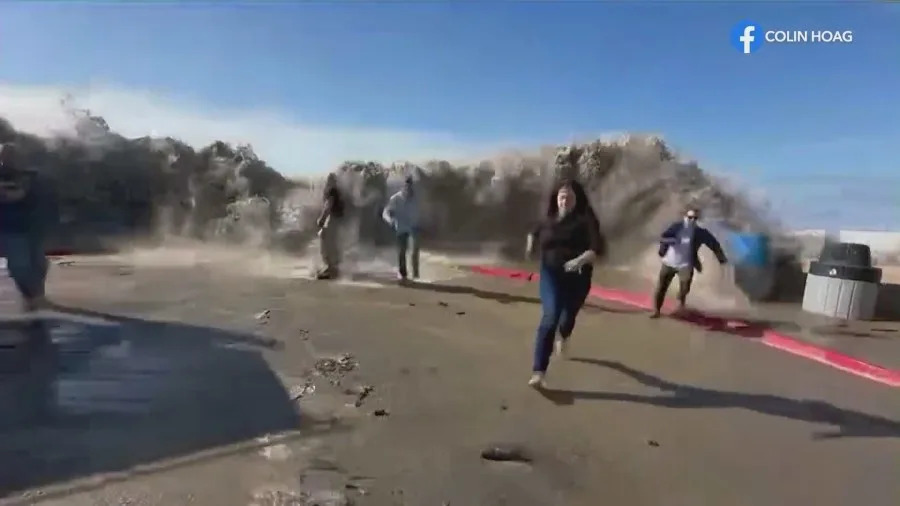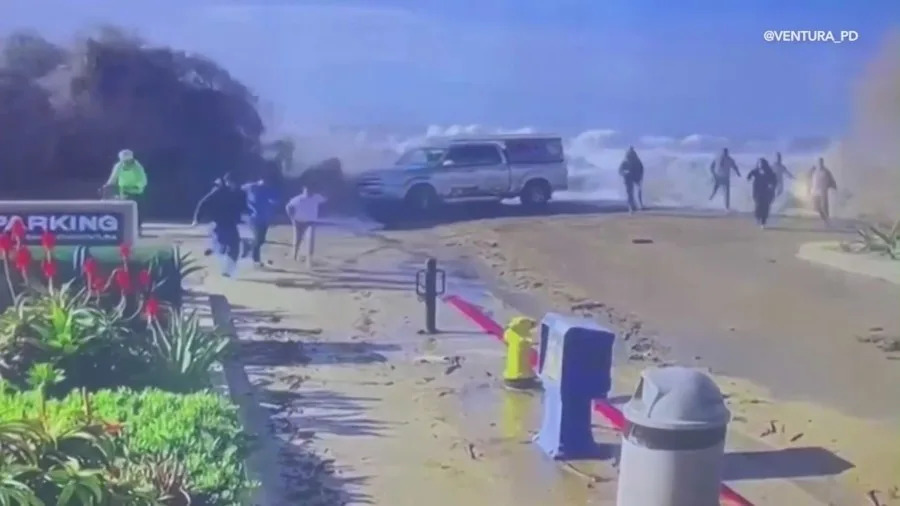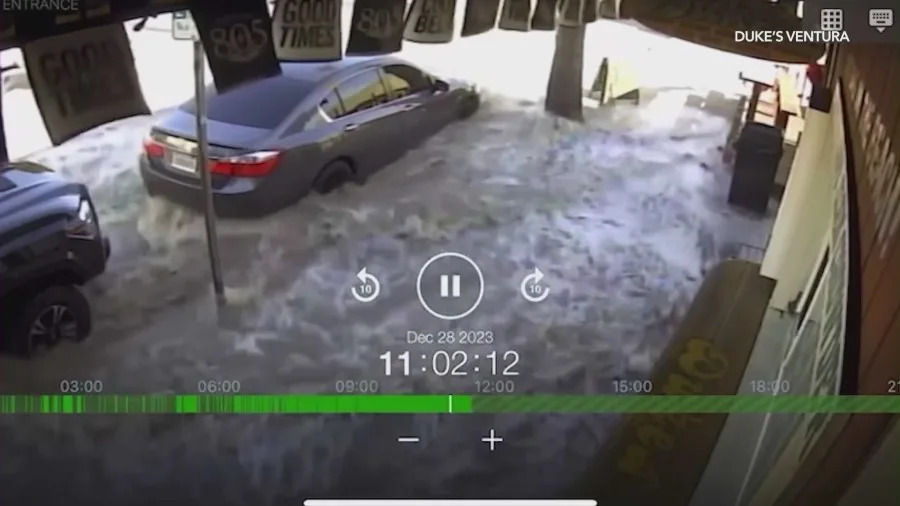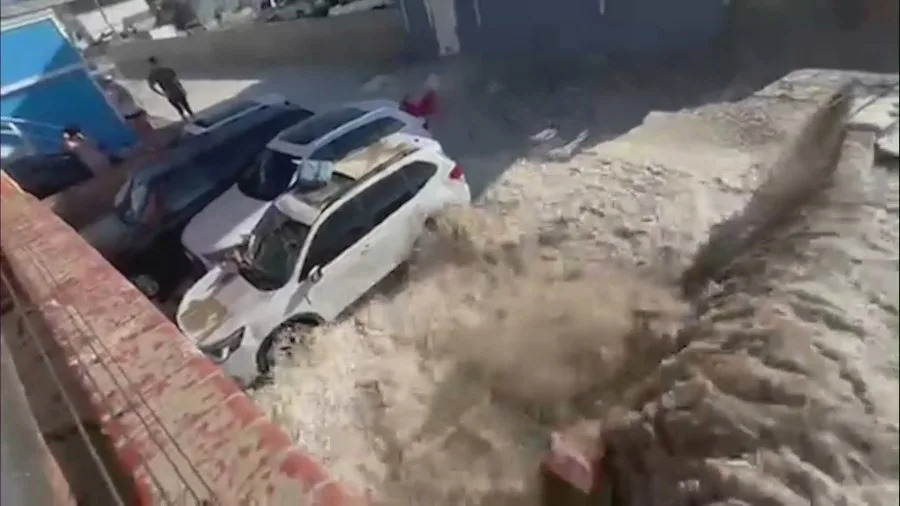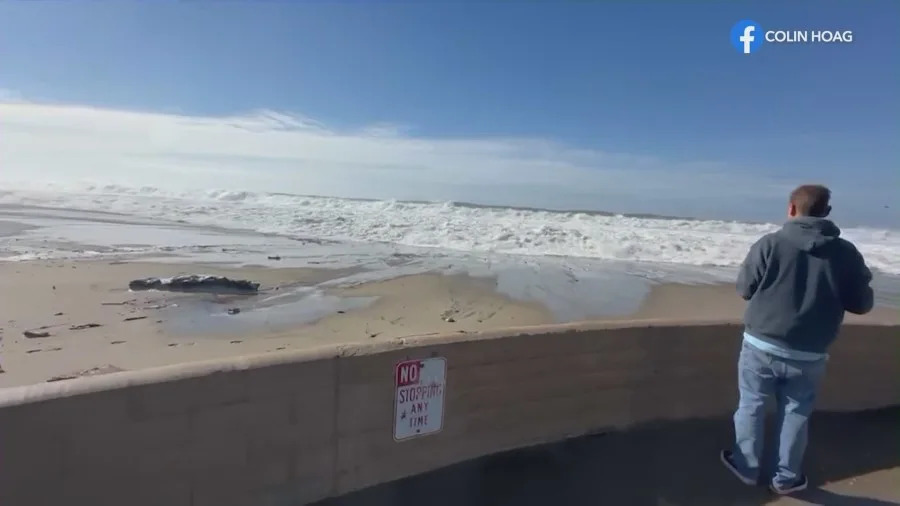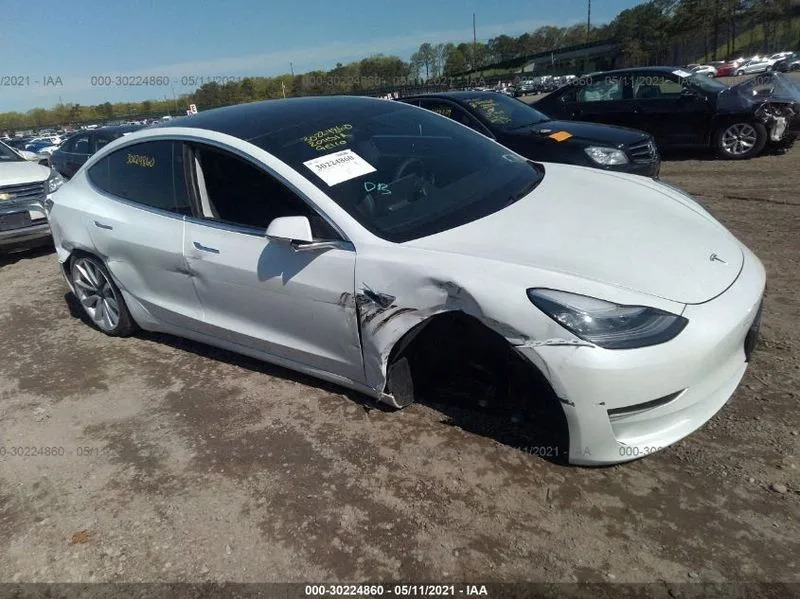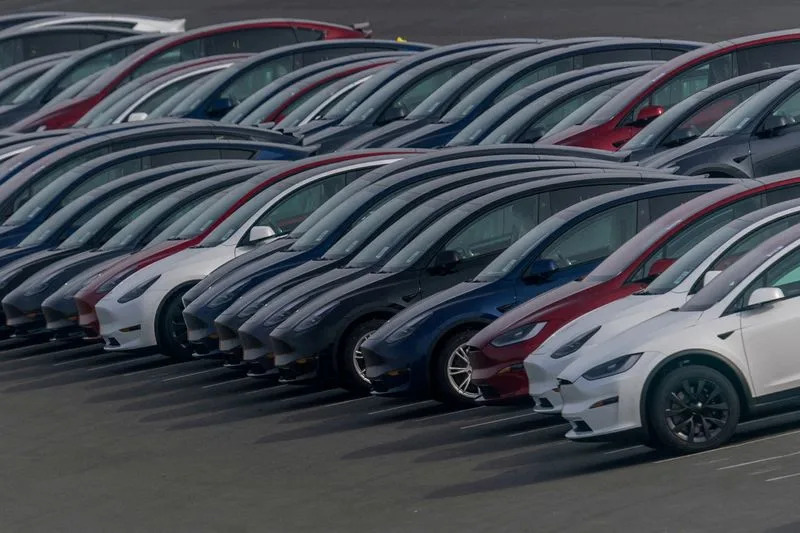Emad Moussa
Los Angeles Times
Thu, December 28, 2023

Palestinians take shelter in a U.N.-run school from the ongoing Israeli strikes on the Gaza Strip in Nuseirat refugee camp on Oct. 14. (Hatem Moussa / Associated Press)
For the past 11 weeks, we Palestinians have seen enough tragedies to fill several lifetimes.
More than 20,000 of us in the Gaza Strip have been killed by Israel. An analysis found that’s proportionally higher than the average civilian death toll in conflicts from World War II till the 1990s. Two million Gazans are now displaced inside this narrow and impoverished piece of land — crammed into homes, schools or in tents on the rubble that once was our homes. The majority are on the verge of starvation.
Read more: Opinion: Gaza's techies were dreamers and builders. After Israel's bombs, their stories shatter my heart
The soaring numbers may no longer shock you. Your becoming inured to our suffering is part of the dehumanization that we Palestinians must endure.
But we are not merely horrific statistics. I am from Gaza and to me, these figures have faces, names and stories of and about people whom I love and know.
Read more: Opinion: What Biden's staunch support for Israel's war in Gaza will cost America
As a fellow Palestinian and friend here in the U.K. put it recently, banging the table: “They killed Gaza’s intellectual and professional elite, destroyed libraries, ancient mosques and churches, and cultural centers throughout the strip. What have the libraries done to them?”
The general impression among us Palestinians — whether at home or abroad — is that as Israeli tanks rolled into Gaza, what the soldiers saw contradicted their worldview of the inferior, subhuman Palestinian. They had to destroy all and re-create an image of Gaza that matched their imagined worldview. As if to say, dehumanize to facilitate and justify the culling.
Read more: Opinion: When libraries like Gaza's are destroyed, what's lost is far more than books
This realization is so upsetting that it overwhelms one with an uncontrollable urge to prove one’s humanity. There is also an urge to communicate, to externalize that feeling.
To ask ourselves, and to ask you: What does it feel like to be dehumanized?
Read more: Opinion: Not far from Bethlehem, the plight of pregnant women in Gaza evokes a biblical story
We have been denied agency, as a people and as individuals. And, with the loss of agency, whatever aspirations for justice and self-determination we have — the basics you take for granted — became meaningless.
Some of you are finally starting to pay attention, although we remain outraged that this had to come at the expense of 20,000 lives. But you may still not know what it feels like to be dehumanized. So, please, allow me to take you into our Palestinian circle.
Perhaps the hardest part is processing the dehumanization, which triggers three negative emotions: a burning but incomprehensible sense of humiliation, guilt and rage. Each one of these emotions feeds into the other to create the perfect psychological storm within one’s soul.
“I feel guilty about feeling humiliated, but I am also shaking with a raging how-dare-you, you force me to justify my humanity?” another friend, a university lecturer in the U.K., told me.
I see where she is coming from. On the receiving end of dehumanization, you are stripped of your moral worth. It feels like others have no obligation to grant you the moral standards that are generally reserved for those whom they consider fully human. That typically leads to distorted self-awareness and a sense of dissociation from reality.
My friend’s words raise the question: Why do so many of us, in Gaza and abroad, feel ragingly humiliated by the loss of our loved ones?
Is it helplessness? Or because we did not have the chance to say goodbye? Or because we have yet to process the loss and grief?
I think it may be the randomness and pointlessness of the deaths, the horrifyingly quick and undignified burials, or worse, the scenes of decomposed bodies on the streets. Is this what it comes down to?
After all, many of us feel we are being culled, usually a term reserved for animals. Israeli leaders have called us “human animals,” treated us for decades as such, and now their bombs are eliminating evidence that contradicts their view of us.
Some people in Gaza spoke to me about apathy, numbness and desensitization, as if the lack of feeling is their coping mechanism to sever themselves from their natural emotionality, and to preserve what is left of their sense of self and dignity.
My mother did this by going out to visit my aunt who sheltered in a UNRWA school at the Nuseirat refugee camp, not caring for the potential Israeli snipers on top of the nearby buildings.
“I did not care, I even walked in the middle of the street,” she said, to my absolute horror.
She was seeking meaning in seeing her sister, and re-establishing her sense of free will and self-worth that often came out of her social life.
I wonder, to external eyes, are the dead and injured we see pulled from the rubble covered in blood viewed as victims, or does their roughed-up state lessen their humanity?
We Palestinians do not choose to be roughed up. How can we prove to you that we are worthy humans?
To tell you that Gaza — where people now line up for hours to get some water — has one of the world’s lowest illiteracy rates and highest rates of PhD holders per capita?
Or perhaps I can tell you about my cousin’s wife, Iman, the mathematical genius, who was killed with her kids last week.
Maybe you want to hear about my friend Jehad, the calligrapher, and the most generous, funniest man you could ever meet. They killed him and his family as they slept in his home in Shujaiya in eastern Gaza City.
How about Mahmoud, the doctor, who was killed by an Israeli sniper at Awda Hospital in northern Gaza?
It is painful to think of their former existence as irrelevant. It is even more painful to think of their death as meaningless.
Against all odds, they persevered and achieved highly. If anything, they were a special kind of human.
I wish you could have met them.
Emad Moussa is a Palestinian-British researcher and writer specializing in the political psychology of inter-group and conflict dynamics.
This story originally appeared in Los Angeles Times.
Thu, December 28, 2023

Palestinians take shelter in a U.N.-run school from the ongoing Israeli strikes on the Gaza Strip in Nuseirat refugee camp on Oct. 14. (Hatem Moussa / Associated Press)
For the past 11 weeks, we Palestinians have seen enough tragedies to fill several lifetimes.
More than 20,000 of us in the Gaza Strip have been killed by Israel. An analysis found that’s proportionally higher than the average civilian death toll in conflicts from World War II till the 1990s. Two million Gazans are now displaced inside this narrow and impoverished piece of land — crammed into homes, schools or in tents on the rubble that once was our homes. The majority are on the verge of starvation.
Read more: Opinion: Gaza's techies were dreamers and builders. After Israel's bombs, their stories shatter my heart
The soaring numbers may no longer shock you. Your becoming inured to our suffering is part of the dehumanization that we Palestinians must endure.
But we are not merely horrific statistics. I am from Gaza and to me, these figures have faces, names and stories of and about people whom I love and know.
Read more: Opinion: What Biden's staunch support for Israel's war in Gaza will cost America
As a fellow Palestinian and friend here in the U.K. put it recently, banging the table: “They killed Gaza’s intellectual and professional elite, destroyed libraries, ancient mosques and churches, and cultural centers throughout the strip. What have the libraries done to them?”
The general impression among us Palestinians — whether at home or abroad — is that as Israeli tanks rolled into Gaza, what the soldiers saw contradicted their worldview of the inferior, subhuman Palestinian. They had to destroy all and re-create an image of Gaza that matched their imagined worldview. As if to say, dehumanize to facilitate and justify the culling.
Read more: Opinion: When libraries like Gaza's are destroyed, what's lost is far more than books
This realization is so upsetting that it overwhelms one with an uncontrollable urge to prove one’s humanity. There is also an urge to communicate, to externalize that feeling.
To ask ourselves, and to ask you: What does it feel like to be dehumanized?
Read more: Opinion: Not far from Bethlehem, the plight of pregnant women in Gaza evokes a biblical story
We have been denied agency, as a people and as individuals. And, with the loss of agency, whatever aspirations for justice and self-determination we have — the basics you take for granted — became meaningless.
Some of you are finally starting to pay attention, although we remain outraged that this had to come at the expense of 20,000 lives. But you may still not know what it feels like to be dehumanized. So, please, allow me to take you into our Palestinian circle.
Perhaps the hardest part is processing the dehumanization, which triggers three negative emotions: a burning but incomprehensible sense of humiliation, guilt and rage. Each one of these emotions feeds into the other to create the perfect psychological storm within one’s soul.
“I feel guilty about feeling humiliated, but I am also shaking with a raging how-dare-you, you force me to justify my humanity?” another friend, a university lecturer in the U.K., told me.
I see where she is coming from. On the receiving end of dehumanization, you are stripped of your moral worth. It feels like others have no obligation to grant you the moral standards that are generally reserved for those whom they consider fully human. That typically leads to distorted self-awareness and a sense of dissociation from reality.
My friend’s words raise the question: Why do so many of us, in Gaza and abroad, feel ragingly humiliated by the loss of our loved ones?
Is it helplessness? Or because we did not have the chance to say goodbye? Or because we have yet to process the loss and grief?
I think it may be the randomness and pointlessness of the deaths, the horrifyingly quick and undignified burials, or worse, the scenes of decomposed bodies on the streets. Is this what it comes down to?
After all, many of us feel we are being culled, usually a term reserved for animals. Israeli leaders have called us “human animals,” treated us for decades as such, and now their bombs are eliminating evidence that contradicts their view of us.
Some people in Gaza spoke to me about apathy, numbness and desensitization, as if the lack of feeling is their coping mechanism to sever themselves from their natural emotionality, and to preserve what is left of their sense of self and dignity.
My mother did this by going out to visit my aunt who sheltered in a UNRWA school at the Nuseirat refugee camp, not caring for the potential Israeli snipers on top of the nearby buildings.
“I did not care, I even walked in the middle of the street,” she said, to my absolute horror.
She was seeking meaning in seeing her sister, and re-establishing her sense of free will and self-worth that often came out of her social life.
I wonder, to external eyes, are the dead and injured we see pulled from the rubble covered in blood viewed as victims, or does their roughed-up state lessen their humanity?
We Palestinians do not choose to be roughed up. How can we prove to you that we are worthy humans?
To tell you that Gaza — where people now line up for hours to get some water — has one of the world’s lowest illiteracy rates and highest rates of PhD holders per capita?
Or perhaps I can tell you about my cousin’s wife, Iman, the mathematical genius, who was killed with her kids last week.
Maybe you want to hear about my friend Jehad, the calligrapher, and the most generous, funniest man you could ever meet. They killed him and his family as they slept in his home in Shujaiya in eastern Gaza City.
How about Mahmoud, the doctor, who was killed by an Israeli sniper at Awda Hospital in northern Gaza?
It is painful to think of their former existence as irrelevant. It is even more painful to think of their death as meaningless.
Against all odds, they persevered and achieved highly. If anything, they were a special kind of human.
I wish you could have met them.
Emad Moussa is a Palestinian-British researcher and writer specializing in the political psychology of inter-group and conflict dynamics.
This story originally appeared in Los Angeles Times.
Opinion
Letters to the Editor: Israel is making Gaza uninhabitable. The Oct. 7 attack doesn't justify this cruelty
Los Angeles Times Opinion
Thu, December 28, 2023

Israeli Prime Minister Benjamin Netanyahu, center, visits soldiers in the northern Gaza Strip on Monday. (Avi Ohayon / Associated Press)
To the editor: The headline, "Egypt floats plan to end Israel-Hamas war. The proposal gets a cool reception," says it all. Hamas and Israeli Prime Minister Benjamin Netanyahu don't care about casualties.
Specifically alarming, before starting the bombing of Gaza, Israel acted as if it knew where Hamas' leadership was hiding, implying a quick end to any conflict. The truth has emerged: Israel knew the location wasn't really specific, but just somewhere or everywhere in Gaza.
That justified Israel's battle plan of flattening Gaza and withholding most of life's necessities. Israel isn't targeting Hamas as much as it is creating an uninhabitable Gaza.
Not all Israelis support Netanyahu and his scorched-earth Gaza massacre, but they seem powerless to stop it. The U.S. is failing to seriously limit the carnage as we continue to provide weapons to Israel.
Hamas has no excuse for its Oct. 7 attack, and Israel has no excuse for obliterating civilian Gaza.
Mark Davidson, Santa Ana
After dozens of relatives were killed in Gaza, Arizonan seeks help for family still there
Letters to the Editor: Israel is making Gaza uninhabitable. The Oct. 7 attack doesn't justify this cruelty
Los Angeles Times Opinion
Thu, December 28, 2023

Israeli Prime Minister Benjamin Netanyahu, center, visits soldiers in the northern Gaza Strip on Monday. (Avi Ohayon / Associated Press)
To the editor: The headline, "Egypt floats plan to end Israel-Hamas war. The proposal gets a cool reception," says it all. Hamas and Israeli Prime Minister Benjamin Netanyahu don't care about casualties.
Specifically alarming, before starting the bombing of Gaza, Israel acted as if it knew where Hamas' leadership was hiding, implying a quick end to any conflict. The truth has emerged: Israel knew the location wasn't really specific, but just somewhere or everywhere in Gaza.
That justified Israel's battle plan of flattening Gaza and withholding most of life's necessities. Israel isn't targeting Hamas as much as it is creating an uninhabitable Gaza.
Not all Israelis support Netanyahu and his scorched-earth Gaza massacre, but they seem powerless to stop it. The U.S. is failing to seriously limit the carnage as we continue to provide weapons to Israel.
Hamas has no excuse for its Oct. 7 attack, and Israel has no excuse for obliterating civilian Gaza.
Mark Davidson, Santa Ana
Daniel Gonzalez, Arizona Republic
Wed, December 27, 2023
Mohamed El-Sharkawy has lived in the U.S. for 37 years.
But like many Palestinian Americans, El-Sharkawy, 63, still has relatives living in Gaza, including four nieces and their families. Now, El-Sharkawy said, those relatives are battling to stay alive amid Israel's bombardment and siege of the territory in response to the Oct. 7 deadly rampage by Hamas.
El-Sharkawy, a Phoenix resident and aviation engineer, is trying to secure safe passage for relatives from Gaza with help from members of Arizona's congressional delegation. A nephew and a niece were able to come to the U.S. in November with help from the office of U.S. Rep. Greg Stanton, D-Ariz.
For now, many of El-Sharkawy's relatives remain in Gaza, living in deplorable and dangerous conditions due to limitations on who the federal government can help leave Gaza to come to the U.S., according to El-Sharkawy and Stanton's office.
El-Sharkawy said he is among many Palestinian Americans in Arizona and other parts of the U.S. who have sought help from the U.S. government to get relatives out of Gaza since the war started.
Some family members of U.S. citizens have complained that guidance from the federal government has been inadequate, according to USA TODAY.
In December, two Palestinian American families sued the Biden administration, saying the U.S. government has not done enough to help evacuate U.S. citizen relatives stuck in Gaza.
In El-Sharkawy's case, the relatives in Gaza are not U.S. citizens, which further limits the role the U.S. can play in helping them secure safe passage.
Arizonans concerned for relatives living in Palestinian territories
About 134,000 to 175,000 people in the U.S. in 2020 identified as being of Palestinian descent, according to the U.S. Census Bureau. Many still have relatives in the Palestinian territories.
Phoenix residents and sisters Lina Bearat, 33, and Hanin Bearat, 39, have relatives in the West Bank, including their parents.
As Palestinian Americans, watching news coverage of Gaza has taken a huge emotional toll, they said.
"To see how we've been dehumanized," Lina Bearat said. "A Palestinian life doesn't matter as much. And so this is what really hurts as a Palestinian American."
Wed, December 27, 2023
Mohamed El-Sharkawy has lived in the U.S. for 37 years.
But like many Palestinian Americans, El-Sharkawy, 63, still has relatives living in Gaza, including four nieces and their families. Now, El-Sharkawy said, those relatives are battling to stay alive amid Israel's bombardment and siege of the territory in response to the Oct. 7 deadly rampage by Hamas.
El-Sharkawy, a Phoenix resident and aviation engineer, is trying to secure safe passage for relatives from Gaza with help from members of Arizona's congressional delegation. A nephew and a niece were able to come to the U.S. in November with help from the office of U.S. Rep. Greg Stanton, D-Ariz.
For now, many of El-Sharkawy's relatives remain in Gaza, living in deplorable and dangerous conditions due to limitations on who the federal government can help leave Gaza to come to the U.S., according to El-Sharkawy and Stanton's office.
El-Sharkawy said he is among many Palestinian Americans in Arizona and other parts of the U.S. who have sought help from the U.S. government to get relatives out of Gaza since the war started.
Some family members of U.S. citizens have complained that guidance from the federal government has been inadequate, according to USA TODAY.
In December, two Palestinian American families sued the Biden administration, saying the U.S. government has not done enough to help evacuate U.S. citizen relatives stuck in Gaza.
In El-Sharkawy's case, the relatives in Gaza are not U.S. citizens, which further limits the role the U.S. can play in helping them secure safe passage.
Arizonans concerned for relatives living in Palestinian territories
About 134,000 to 175,000 people in the U.S. in 2020 identified as being of Palestinian descent, according to the U.S. Census Bureau. Many still have relatives in the Palestinian territories.
Phoenix residents and sisters Lina Bearat, 33, and Hanin Bearat, 39, have relatives in the West Bank, including their parents.
As Palestinian Americans, watching news coverage of Gaza has taken a huge emotional toll, they said.
"To see how we've been dehumanized," Lina Bearat said. "A Palestinian life doesn't matter as much. And so this is what really hurts as a Palestinian American."

Palestinian American sisters Hanin and Lina Bearat from Phoenix.
They also are concerned about relatives in the West Bank. Since the war began, increased violence in the West Bank has forced their families to stop tending their olive groves, which they depend on for economic survival. Their younger cousins also have stopped going to school.
"All these things are impacting our family in the West Bank," Lina Bearat said. "That's not really getting as much coverage because of just the scale of what's going on in Gaza."
'Hungry, cold and scared': Arizonan describes his relatives' lives in Gaza
Israel's air and ground assault began after Hamas launched attacks from Gaza across the border into southern Israel. The attacks killed 1,200 people, including 33 children, and injured thousands. Hamas also took about 240 people hostage.
The air and ground assault by Israel against Hamas prompted by the Oct. 7 attacks has killed more than 20,000 Palestinians, a large share of them children, and displaced most of the Hamas-controlled territory's 2.3 million people, according to USA TODAY.
About 50 members of El-Sharkawy's extended family have been killed in Gaza, including an entire family killed when a bomb destroyed an apartment building in Gaza City where they were living in early November, he said. Those killed in the blast were the family of the husband of one of his nieces living in Gaza City, El-Sharkawy said.
His niece's husband's family "were all wiped out — everybody," El-Sharkawy said. She lost "her father-in-law and mother-in-law, all of the kids," El-Sharkawy said.
It is common for entire extended families in Gaza to live in a single compound, El-Sharkawy said, explaining why so many members of the same family were killed in the blast.
El-Sharkawy said two of his nieces in Gaza are the daughters of a sister who lives in Jacksonville, Florida. The other two are daughters of a sister in Spain.
El-Sharkawy said his four nieces and their immediate families still in Gaza have all been displaced from their homes in northern Gaza. The families include 10 children, among them a 1-year-old.
"These kids are hungry, cold and scared," El-Sharkawy said.
El-Sharkawy said the neighborhood where he grew up in Gaza City has been reduced to rubble by the shelling.
Some of El-Sharkawy's relatives were living in Jabalia, in the northern part of Gaza. But when the bombardment started, they fled to nearby Gaza City. The four nieces and their families are now living in Rafah, a city in southern Gaza near the border with Egypt, El-Sharkawy said. Hundreds of thousands of people who also fled the bombardment are starving in crowded, squalid conditions, according to media reports.
El-Sharkawy said three of his nieces and their families live in tents with little to eat. The fourth niece and her family are living in a U.N.-run school providing shelter to displaced Palestinians. The school also has been hit by Israeli airstrikes, according to media reports.
Photographs that El-Sharkawy shared show one niece, 36-year-old Doaa Nijim, frying tomatoes and onions on a wood stove, and washing clothes in a plastic paint bucket. Another photo shows Doaa Nijim's son, 12-year-old Rezeq Nijim, curled up asleep on a thin mat on the floor.
A spoon of sugar is sometimes all Doaa Nijim has to feed her children as a sweet, El-Sharkawy said.
The entire population of the Gaza Strip is facing acute food insecurity, and more than half of a million people in the Gaza Strip are starving due to the war, according to an Integrated Food Security Phase Classification report.
"They are crying day and night, not knowing if they will make it the next day," said El-Sharkawy during an interview at a restaurant in Ahwatukee Foothills, where he lives. "The hardest part is their kids crying, and they can't comfort them. They cannot tell them tomorrow will be better."
Nephew makes asylum claim, placed in detention after US arrival
El-Sharkawy said he called the offices of Stanton and U.S. Sen. Mark Kelly, D-Ariz., to ask for the U.S. government's assistance in evacuating his relatives in Gaza.
El-Sharkawy came to the U.S. in 1986 after earning an engineering degree in Cairo. He founded the Arizona Muslim Police Advisory Board. The board's goal is to facilitate communication between law enforcement agencies and the Muslim population, he said.

Palestinian American Mohamed El-Sharkawy poses for a portrait in his home on Dec. 21, 2023, in Phoenix. He looks down at a framed photograph of his four nieces who are currently in Gaza with their homes destroyed.
Through his work with the board, El-Sharkawy said, he has had a long relationship with Stanton, the former mayor of Phoenix, which is why he reached out to him now. El-Sharkawy said he also became acquainted with Kelly's wife, former U.S. Rep. Gabrielle Giffords, through his work with the board.
Representatives from Stanton and Kelly's offices confirmed that El-Sharkawy had requested help bringing relatives to the U.S. from Gaza.
Kelly spokesman Alex Wood said Kelly's constituent services team is assisting El-Sharkawy, but he declined to share details of the communications for privacy reasons.
Stanton spokesperson Allison Childress said El-Sharkawy first contacted Stanton's office on Oct. 13 about a niece and nephew trying to leave Gaza.
The U.S. government does not provide departure assistance for noncitizens, Childress said. But the niece and nephew managed to cross from Rafah into Egypt, where they received 72-hour temporary visas, Childress said.Representatives from Stanton's office contacted the U.S. Department of State and the Egyptian government about extending the temporary visas, Childress said. Stanton raised the case directly with U.S. Assistant Secretary of State for Near Eastern Affairs Barbara Leaf on Nov. 8., Childress said.
"We worked to move the niece and nephew’s appointment from November 19 up to November 13 at the U.S. Embassy in Cairo for them to interview for visas," Childress said in an email.
On Nov. 14, the nephew’s student visa and the niece’s 60-day visitor visa were approved. They flew to the U.S. shortly after, Childress said.
The niece and nephew are both now on U.S. soil, Childress said.
However, because the nephew arrived more than 60 days before the start of classes in January at Florida State College, where he plans to attend school, he was denied entry at John F. Kennedy International Airport in New York City, Childress said.
The nephew then claimed asylum, Childress said. He is in detention awaiting adjudication of his asylum case, Childress said. Stanton's office informed the U.S. Department of Homeland Security and the State Department about the ongoing case.
"They have retained legal counsel, at our recommendation," Childress said.
Stanton's office also has contacted the State Department about El-Sharkawy's other nieces and their young children. They missed a travel visa appointment in Jerusalem due to the conflict, Childress said.
They are attempting to move the appointment to the U.S. Embassy in Cairo, Childress said.
"But at this point our office is only able to assist once the family has moved to a third country with a U.S. Embassy in it," Childress said.
Helping out: Arizona volunteers' donations are meant to bring warmth to war-torn Gaza
The U.S. government is only able to assist U.S. citizens in Gaza and their immediate family members, defined as parents, spouses, unmarried children and siblings under 21, to get on published lists of people approved to depart from Gaza, Childress said. The published lists are posted on the Facebook page of the Palestinian General Authority for Crossings and Borders.
"The situation in Gaza remains fluid, and there have been delays and periodic, unexpected closures of the Rafah crossing. The U.S. does not control the crossing, and every day, it's a series of negotiations and discussions about process, procedure, and security vetting," Childress said in the email. Childress said Stanton's office "is exploring all available options" to help El-Sharkawy and his family in Gaza.
Reach the reporter at daniel.gonzalez@arizonarepublic.com.
This article originally appeared on Arizona Republic: Phoenix resident seeks help getting relatives out of Gaza
Some Muslim American advocates hesitant to work with White House on Islamophobia
Willie James Inman
Updated Thu, December 28, 2023
The White House's push to create a strategy to counter Islamophobia is facing reluctance amid a spike in hate-fueled incidents against Arab and Muslim Americans since Hamas' Oct. 7 attack on Israel.
CBS News spoke with several Muslim and Arab American advocates who voiced frustration with the Biden administration's response to the situation in Gaza, citing the increasing number of civilians that have been killed and President Biden stopping short of calling for a cease-fire.
Muslim American advocate Salam Al-Marayati has worked with the Biden White House in the past. But despite the Biden administration's efforts to craft a strategy to counter Islamophobia in the U.S., he's skeptical about working with them in the future.
"At this moment in time, it is very hard to even imagine how a national strategy to counter Islamophobia will work, Al-Marayati, the president of the Muslim Public Affairs Council, which is also a member of the American Muslim Community Coalition, told CBS News. "American Muslims here in the United States feel unsafe and unsupported as they witness the horrific attacks on Palestinians in Gaza. Muslim families, students, and employees are afraid to speak out for fear of retribution as many who have spoken out have faced retaliatory action including loss of employment, suspension, censorship, trolling, bullying, and targeted violence."

President Joe Biden walks to the South Lawn before boarding Marine One and departing the White House on December 05, 2023 in Washington, DC. / Credit: Anna Moneymaker / Getty Images
The White House announced on Nov. 1 plans to develop a national strategy to counter Islamophobia, led by the Domestic Policy and National Security Councils. The proposal follows an announcement in May marking the federal government's first-ever National Strategy to Counter Antisemitism. Conversations and meetings on the development of the Islamophobia strategy date back a year, according to a senior administration official who said engagement with stakeholders in the community is ongoing with additional meetings scheduled for early next year. The effort is part of a White House interagency policy committee created in Dec. 2022 that focuses on countering antisemitism, Islamophobia and related types of discrimination.
"[The development of the strategy] should be really welcome news. I think the challenge is given what's going on and especially with the death toll and destruction rising and rising, people are understandably very hurt, angry, shocked [and] frustrated at America's involvement in this," said another source close to the discussions surrounding the development of the strategy. "And so the timing of these two different things overlapping even though they are totally separate is really challenging. And unfortunately I don't know what will happen with the islamophobia strategy as a result."
While some have expressed doubts, others say it is important to continue work on ways to counter hate and solve systemic discrimination problems that have targeted the Arab and Muslim communities for decades.
"We recognize, as do most other communities, that engaging on one issue doesn't mean that you are endorsing or accepting the White House's policies on that issue or any other issue," said Arsalan Suleman, who is board chair and co-founder of America Indivisible, a nonprofit dedicated to combating Islamophobia. "So while I and many other community members have very strong criticisms of the current policy on Gaza, we certainly want to engage with the White House on the Islamophobia strategy, given its importance," Suleman added.
Advocates say a plan to counter Islamophobia in the U.S. is necessary after a spike in anti-Muslim sentiment following Hamas' Oct. 7 attack in Israel. But some question how effective the strategy could be and hesitate to take part in its development. A White House official told CBS News that administration officials are "listening" to the community and that the Biden administration remains committed to the development of a strategy.
"We've had engagements where community members have engaged on the strategy and have also been able to make their points clear about their positions on what's happening overseas in the course of those engagements while they've been focused primarily on the strategy," a senior administration official said. CBS News spoke to the staffer on background to talk candidly about the ongoing development of the strategy. "We want to make sure that we are listening [and] so as a part of their communication with us, when they raise those issues, of course, we're listening to them. And many have made the point that what's happening overseas has an impact on what's happening in the United States in terms of Islamophobia," the official said.
The official insisted that support within the Arab and Muslim American community is strong, citing a letter from the American Muslim Community Coalition applauding the early November announcement.
"We commit to participating actively in the process of supporting the development of the strategy, and look forward to a comprehensive approach that addresses the various drivers of Islamophobia, including deep-rooted institutional manifestations that have plagued our communities for decades," the letter reads.
The White House hopes to complete its work on the strategy in late winter or spring.
The senior administration official also responded to criticism about the timing of the announcement explaining that the White House had planned to announce the development of the strategy well before the Hamas attack in October. Months of conversations and meetings with dozens of Muslim and Arab American groups pre-dated the attack, the official said. An increase in hate-fueled anti-Muslim incidents in the United States — including the deadly stabbing of a 6-year-old Palestinian American boy in the Chicago area — created a need to move forward with announcing the strategy, the official added.
